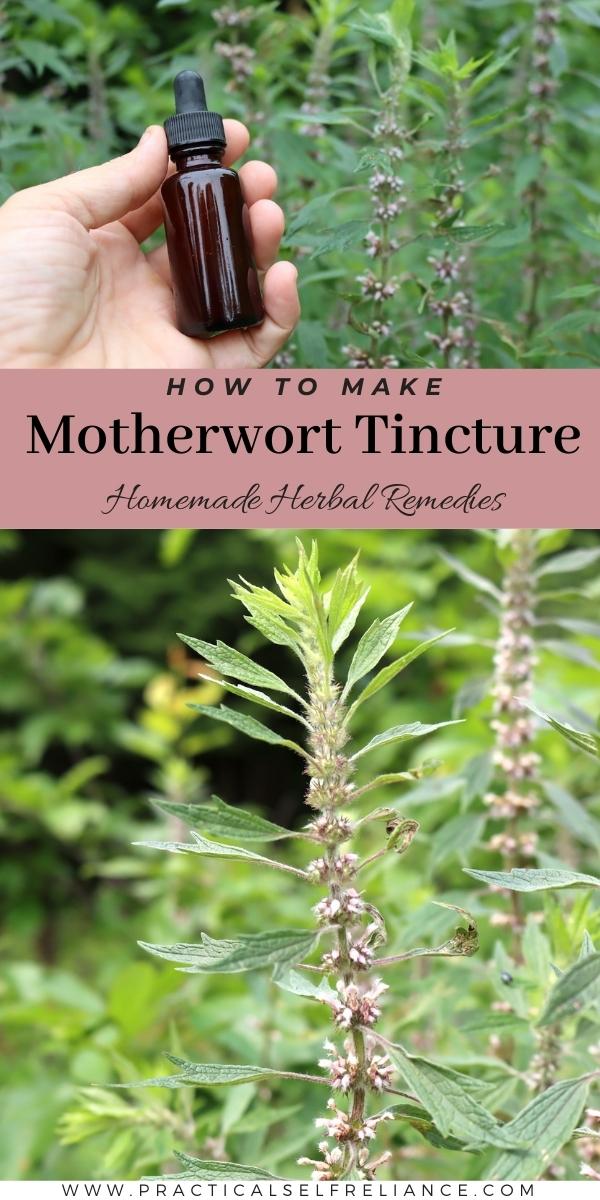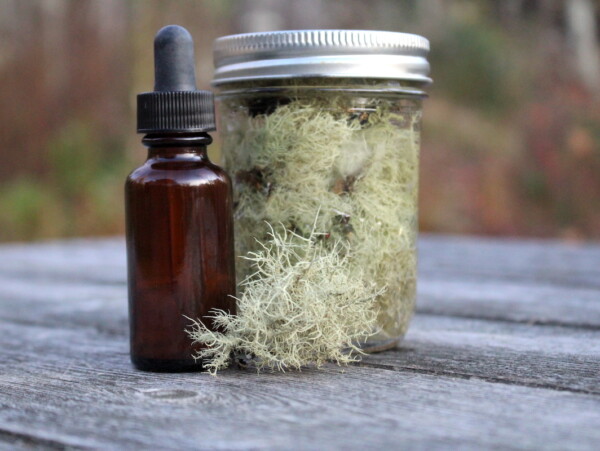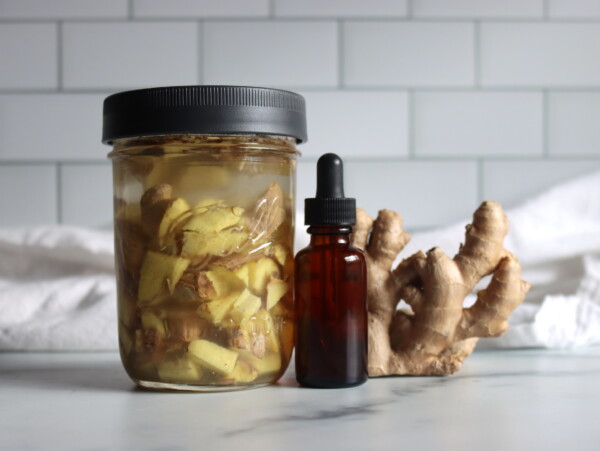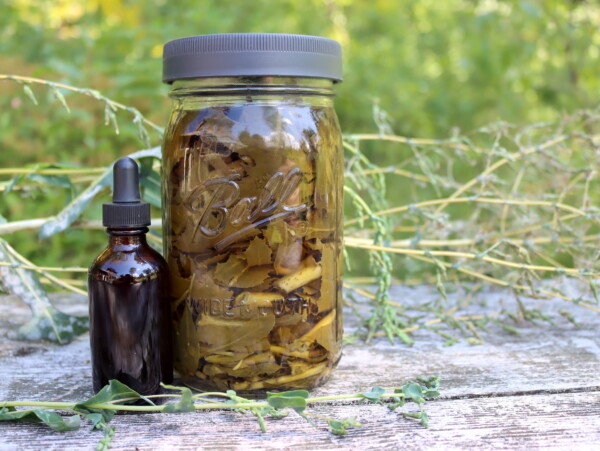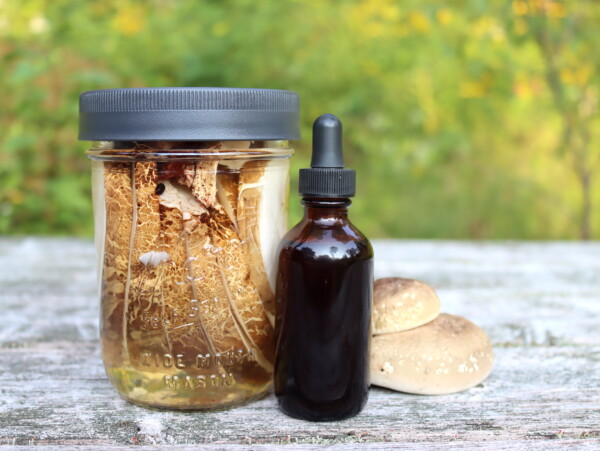Affiliate disclosure: This post may contain affiliate links. Please see our Privacy Policy.
Motherwort tincture is a gentle herbal remedy for for stress, anxiety and depression, as well as physical conditions like excess menstrual and postpartum bleeding and high blood pressure. Mother or not, if you’re feeling stressed and overworked, motherwort is a great herb to have on hand, and it’s the perfect thing for overwhelm. It’s easy to make at home with just a few simple ingredients!
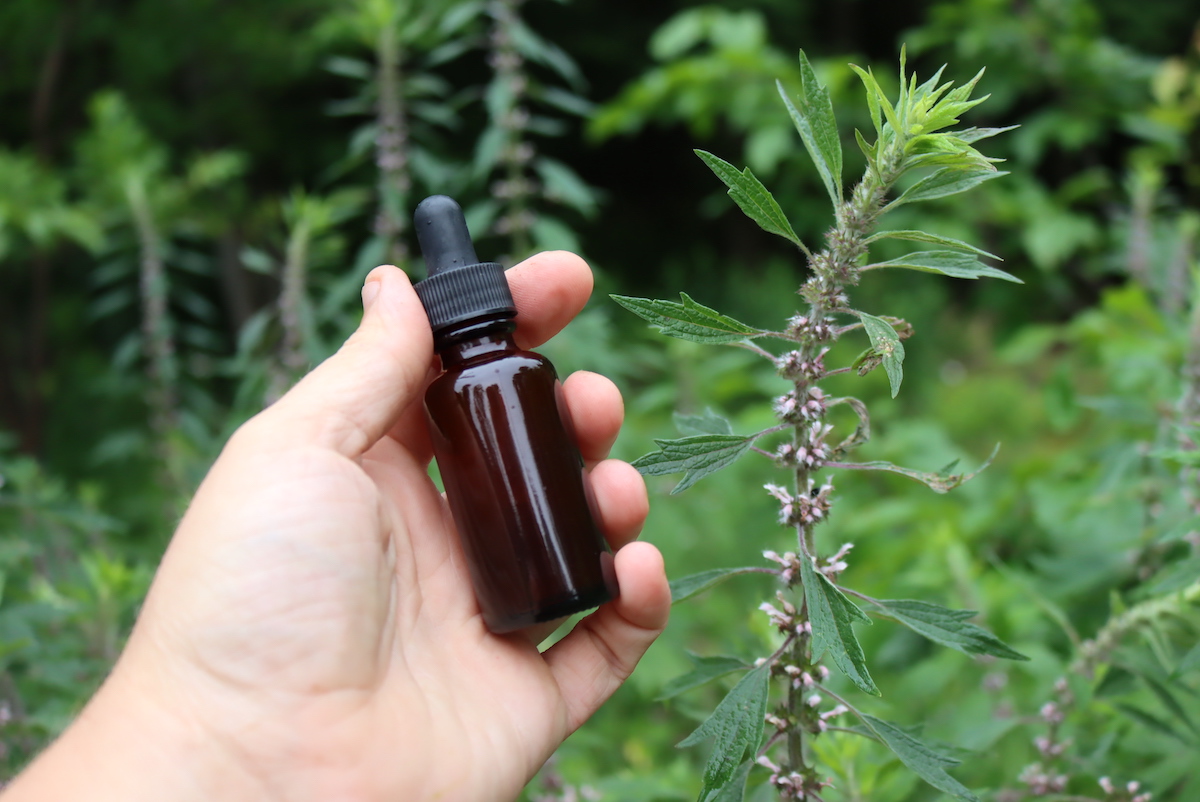
They say motherwort is the perfect herb for mothers, or anyone who needs a little bit of mothering.
When the world is too much, and everything seems to be piling up (be it dirty diapers or just random things at work), motherwort is there to help soothe frazzled nerves and promote a calm, balanced way of being.
We grow this beautiful plant in our herb garden, and it’s available fresh when I need it about 6 months of the year here in Vermont, but sometimes I find myself overwhelmed when it’s out of season. The holiday season comes to mind….
Anyhow, during the rest of the year, I reach for motherwort tincture, and I find it incredibly effective in a pinch.

I’ll walk you through how to make your own motherwort tincture, with either fresh bark or dried motherwort, but if you’re just looking for a source for the tincture, it can be purchased ready made here. This is the basic process for making motherwort tincture, but if you’re looking for more details, I’d recommend the Herbal Academy’s Tincture Making Course which covers everything you could ever want to know about making more than 100 different herbal tinctures, as well as half a dozen tincturing methods.
If you want to try growing motherwort in your garden, seeds are available here. Be careful though, it grows 6-8 feet tall and it’s as vigorous as a weed…it’s known to take over if not kept in check. We grow it at the edge of our orchard where it can be mowed if it starts to get out of hand, but the patch still gets bigger every year.
It’s much loved by bees though, and has a long bloom season, so it’s a lovely addition to that out of the way part of the yard that doesn’t get much attention anyway. Motherwort will take over there, suppressing less desirable weeds, and feeding the bees at the same time.
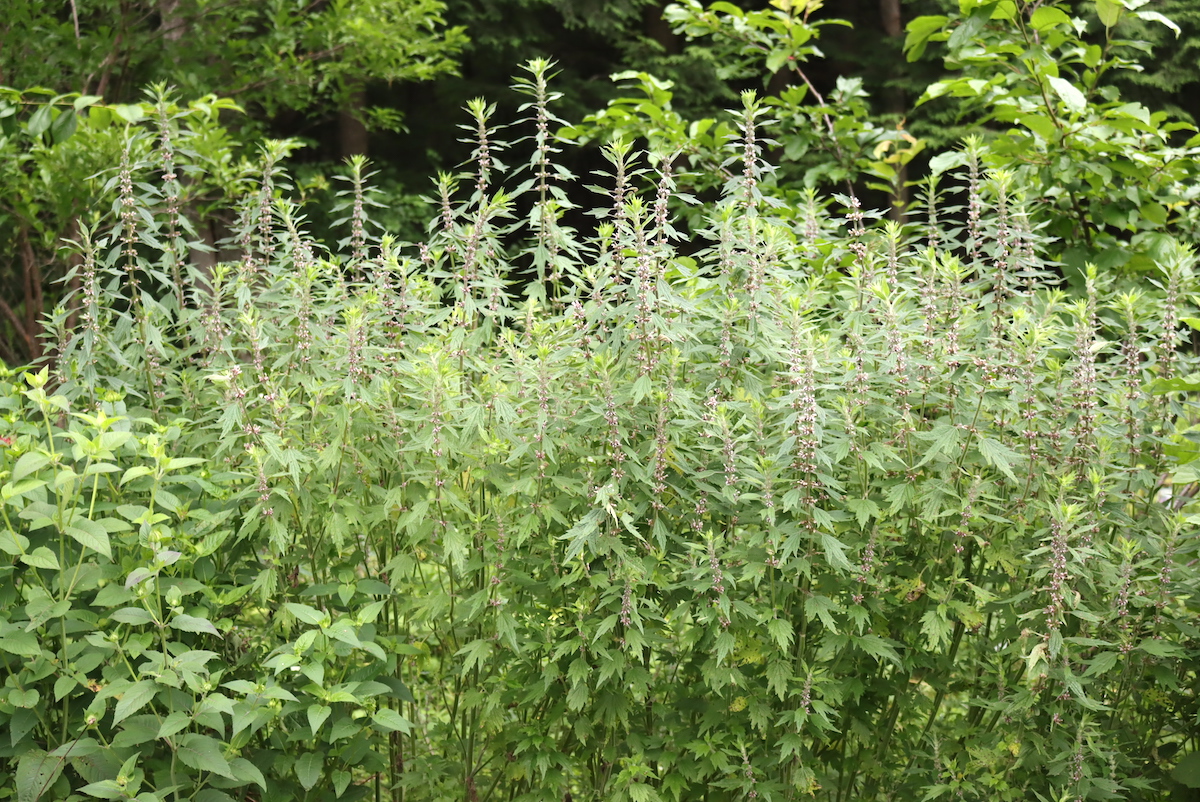
(Always consult your doctor or a clinical herbalist before trying any new herbal remedy, as there’s always the possibility of unintended consequences, allergic reaction, or interactions with other medication. If you’re harvesting wild plant material, make sure you’re 100% confident in your identification and consult multiple sources for your ID. The following is based on my research and experience, but I don’t claim to have any certifications that would qualify me to advise you on your health. Please do your own research and always verify with multiple reputable sources.)
Benefits of Motherwort Tincture
Generally, motherwort tincture is used by herbalists to treat all manner of things that are common in women with children or of childbearing age, but necessarily uterine or menstrual issues (though it does treat those too). It’s used for anxiety and stress that are all too common when a new baby arrives, as well as the sleeplessness that comes with constant interruptions, worry and overwork. Those particular issues are common in mothers, today and historically, but they’re not just issues that birthing women face.
In general, motherwort is an excellent calming herb that helps ground frazzled nerves, lower blood pressure, promotes meaningful and restful sleep, and soothes depression and anxiety of any sort.
This herb also has physical benefits for women specifically.
Motherwort has been in parts of Asia through Chinese medicine for at least 1,800 years, where it has mainly been used as a treatment for menstrual cramps, lack of mensuration, and excessive postpartum bleeding. Today in China, motherwort continues to be widely available as a natural remedy, often in conjunction with pharmaceutical medicine, where it’s “used in the treatment of gynecological and obstetrical diseases, mainly including postpartum hemorrhage, postpartum lochiorrhea, irregular menstruation, and subinvolution of the uterus.”
One particularly interesting modern-day motherwort application (which is used in China) is when it is used to stop heavy bleeding after a natural birth or caesarean section. Oxytocin is often used to treat postpartum hemorrhage, but because it has a short half-life it isn’t always the most efficient or practical of drug choices. When an injection of motherwort is given simultaneously with oxytocin, bleeding is less severe and is shortened during the third stage of labour or during a caesarean section or after a natural birth.
Motherwort is also well-known as a source of powerful antioxidants and for its numerous anti-inflammatory properties. One study followed individuals for 28 days with high blood pressure who also suffered from anxiety, depression, and insomnia and the results were significant: At the end of the study, significant improvement in the areas of anxiety and depression were reported in 32% of patients, while 48% reported moderate improvement.
Another interesting study was conducted using rat cells and found that leonurine, a compound found in motherwort, acts as a calcium channel blocker — meaning it helps lower blood pressure. The antioxidants I mentioned above have also been linked to heart heart, in this case they help protect the heart from damage.
Although dosages may vary depending on their intended use, the recommended dose of motherwort tincture is roughly half- to three-quarters of a teaspoon up to 3 times a day.
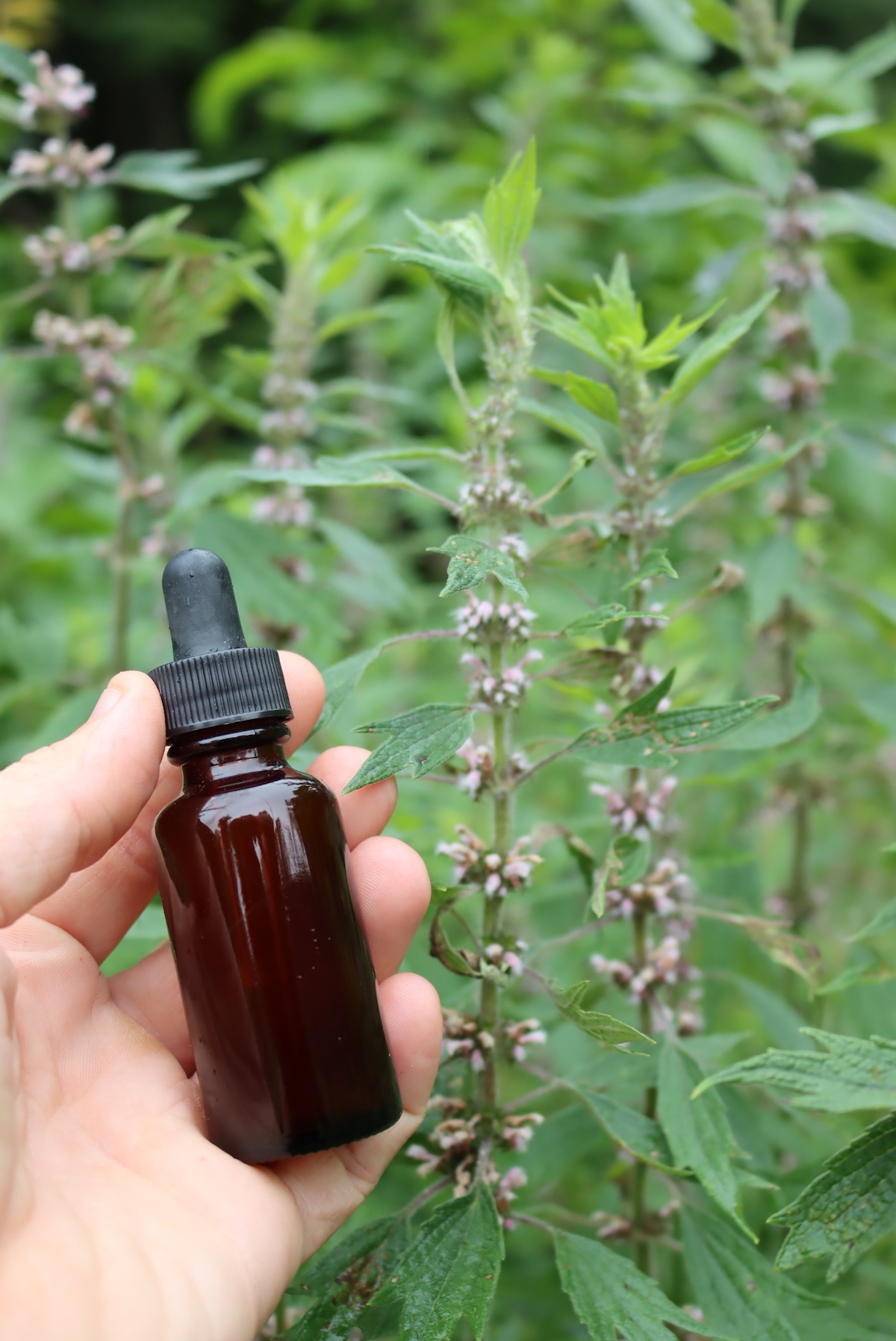
How to Make Motherwort Tincture
To make your own Motherwort tincture, gather the following ingredients and equipment:
- Dried Motherwort
- Vodka* (or any suitable alcohol that’s at least 80 proof/40% — there’s no need for a premium brand; I use Smirnoff for its affordability and neutral taste)**
- One-pint mason jar with lid (amber glass is preferred, but any jar kept away from light will work)
- Funnel
- Cheesecloth
- Fine mesh sieve
- Amber glass tincture bottles (with dropper)
*The Herbal Academy recommends using 40% alcohol for tinctures made with Motherwort, though they suggest using 25% alcohol for mucilaginous herbs and up to 95% for plant resins. Motherwort falls in the middle, as it contains both alcohol-soluble and water-soluble components.
Important: Never use isopropyl or rubbing alcohol for tinctures (or for any internal use). This type of alcohol is toxic and meant for external purposes only.

To begin making the tincture, fill the mason jar about 3/4 of the way with fresh Motherwort, or about halfway if using dried Motherwort. Pour vodka, or your chosen alcohol, over the herb until it’s fully covered. Seal the jar tightly with its lid.
Store the jar in a cool, dark area, and shake it gently every few days (daily shaking is ideal, but tinctures are quite forgiving in terms of frequency).
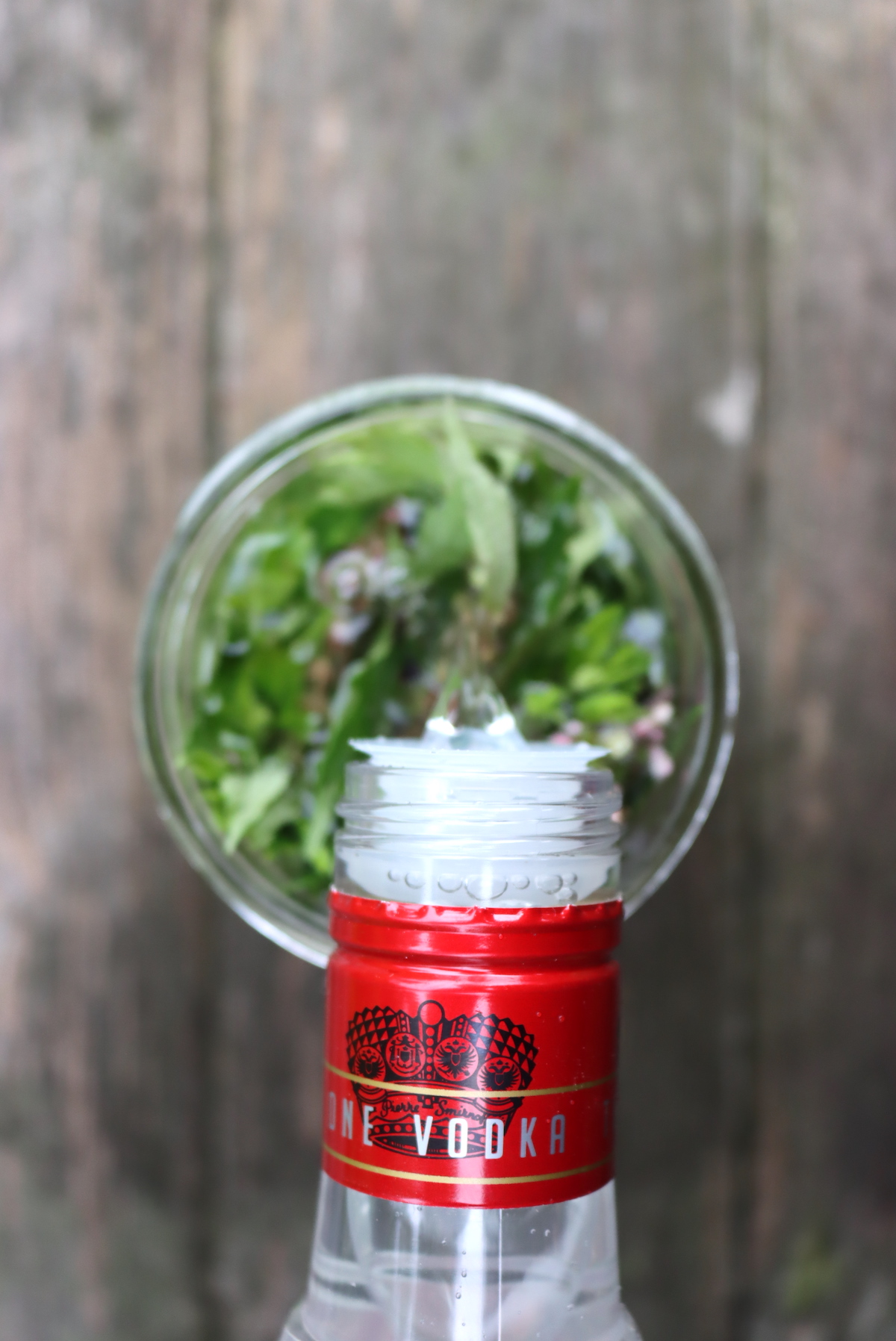
After 4 to 6 weeks, it’s time to strain the tincture. Line a funnel with several layers of cheesecloth and carefully pour the tincture into amber tincture bottles. Squeeze the cheesecloth to extract all the liquid from the Motherwort.
Once the tincture is decanted, label each tincture bottle with the date it was made and any suggested dosages (I use masking tape and a marker for labeling, which can be easily removed later).
For more details on making herbal tinctures, I recommend checking out a guide on tincture-making or exploring the Herbal Academy’s Tincture Making Course.
If you’re in need of immediate relief, you can always purchase a ready-made Motherwort tincture while your homemade version is steeping. While store-bought tinctures are more expensive, they do offer the convenience of being ready when you need them.
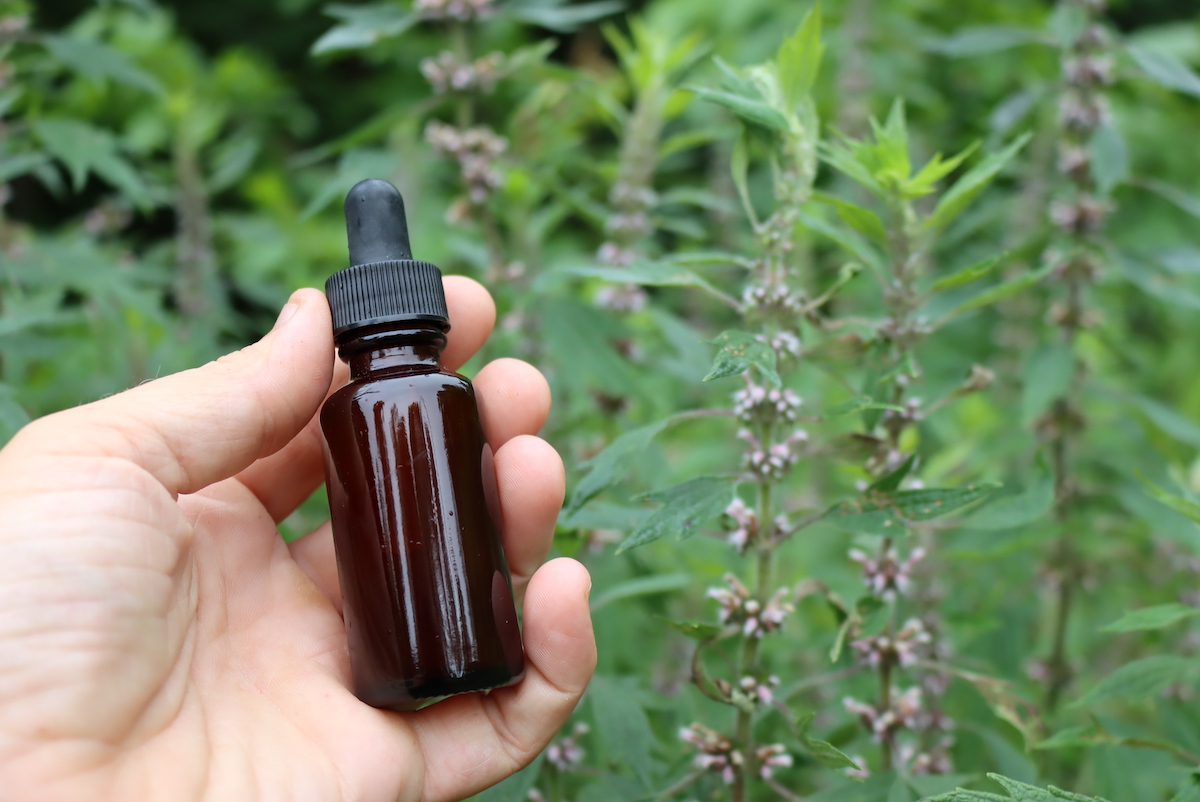
Motherwort Tincture Dosage
For personalized dosing, it’s best to consult with a clinical herbalist. Everyone’s body is a bit different.
However, a general guideline for Motherwort tincture is 1 to 2 droppers full, taken 2 to 3 times per day, or as needed.
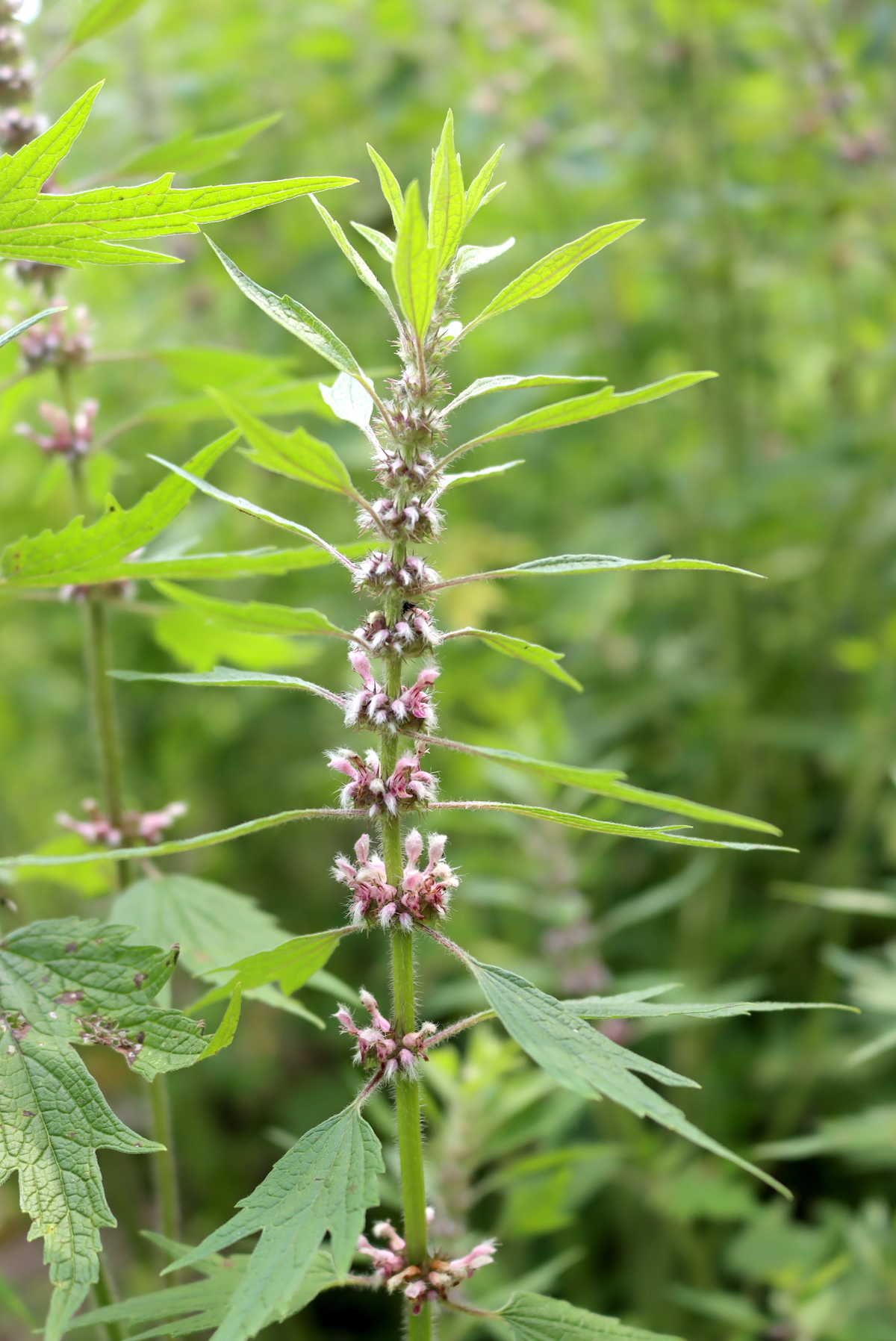
Motherwort Formulations
Motherwort is often combined with other soothing, relaxing herbs that will relieve anxiety and lower blood pressure. Good options are tulsi tincture, chamomile tincture and lavender tincture. When used to promote restful sleep, it goes particularly well with Valerian tincture.
If you’re interested in the science behind combining herbs to enhance their effectiveness, I’d recommend taking this online course in Mastering Herbal Formulations from the Herbal Academy. It covers the science of blending herbs into homemade formulations in detail.

Motherwort Tincture
Equipment
Ingredients
- Motherwort
- Neutral Spirit such as vodka*
Instructions
- Begin by filling a clean, empty mason jar with dried motherwort. If using fresh motherwort, fill the jar about halfway, and if you're using dried, fill it about one-third full. Fresh motherwort tends to be juicier, so it will release moisture into the tincture, meaning it may need more alcohol to cover it fully. Make sure the plant material is loosely packed.
- Pour your alcohol of choice over the motherwort until it's completely submerged. Vodka is the most common base, but you can use brandy, rum, or any alcohol with a proof of 60 or higher. This is essential for preserving the tincture. Ensure that the alcohol completely covers the plant material to properly extract the medicinal properties.
- Seal the jar tightly with a lid and give it a gentle shake to mix the alcohol with the motherwort. Place the jar in a cool, dark place for the extraction process to begin. It’s best to store the jar in a cupboard or pantry, away from light and temperature extremes.
- Over the next 4 to 6 weeks, shake the jar gently every few days to keep the herb evenly submerged in the alcohol. If you're using fresh motherwort, it may float to the top, so keep an eye on the level of alcohol. You may need to add more alcohol if the plant material becomes exposed.
- After 4 to 6 weeks, strain the tincture by placing a fine mesh strainer or cheesecloth over a funnel and pouring the liquid into a dark amber glass bottle. Press the plant material gently to extract every last drop of tincture. You can discard the plant material once you’ve strained it.
- Label the tincture with the date it was made, its contents, and recommended dosage. Store it in a cool, dark location, away from sunlight, to maintain its potency. A dark amber bottle helps preserve the tincture’s quality.
Notes
Expected Yield
When using fresh motherwort, the herb will release more liquid into the tincture, resulting in a slightly higher yield. Dried motherwort, on the other hand, may absorb some of the alcohol, yielding slightly less tincture than the amount of alcohol you started with. A quart jar typically requires about 2 to 3 cups of alcohol, or about 1 to 1.5 cups for a pint jar. Always ensure the plant material is fully submerged throughout the infusion process.Alcohol-Free Option: Glycerite Tincture
If you prefer an alcohol-free tincture, you can use vegetable glycerin to create a glycerite tincture. For this method, cover dried motherwort with a mixture of 3 parts glycerin to 1 part distilled water. If you're using fresh motherwort, you can use only glycerin, skipping the water. As with the alcohol tincture, shake the jar daily and strain after 6 to 8 weeks.Disclaimer on Homemade Herbal Remedies
I’ve been foraging wild medicines and treating my family with herbal remedies for the past 20 years, but I’m self-taught. Be aware that I am not a clinical herbalist, and this is based on my own research and personal experience using medicinal plants. I do not claim to have the experience that’d qualify me to advise you on your health, and I’m only providing this as a reference to encourage a broader interest in medicinal plants.
Please use this as a jumping-off point, but always do your own research and verify anything you read with multiple sources.
It’s always possible to have an adverse reaction to any medicinal herb, and plenty of people are allergic to even gentle herbs like chamomile. Always consult your doctor or a certified herbalist before trying any new medicinal plant. Often, they can have unintended reactions in combination with other herbs and supplements, and many herbs have side effects even when they are effective for their intended purpose.
If you are seriously interested in herbal medicine, I’d suggest investing in a course in herbal medicine, and I’d recommend any of the online courses put out by the Herbal Academy of New England. Specifically, the introduction to herbal medicine course and the family herbalist group of courses.
For resources related specifically to tinctures,I’d recommend the Herbal Academy’s Tincture Making Course which covers everything you could ever want to know about making more than 100 different herbal tinctures, as well as half a dozen tincturing methods.
They also have a mushroom course, covering both medicinal and edible mushrooms, and a Botany and Wildcrafting Course. I’ve taken both and they’re informative, inspiring, and artfully presented.
Herbal Tinctures
Interested in making other homemade herbal tinctures?
- Yarrow Tincture
- Thyme Tincture
- Elderberry Tincture
- Elderflower Tincture
- Burdock Tincture
- Echinacea Tincture
Herbal Medicine Making
Herbal medicines don’t stop at tinctures! Learn how to make more homemade medicine…
